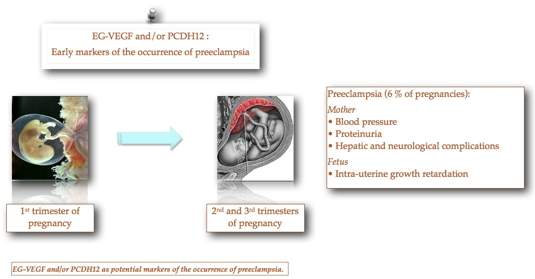Preeclampsia (PE) or gravidic toxemia is the major pathology of human pregnancy. It affects 5 to 6 % of pregnancies and represents a very serious fetal and maternal threat. PE is often diagnosed late, before signs of complications such as (Hypertension, edema, eclampsia and intra-uterine growth retardation). Because of the crisis of the condition, even the take care of the fetus is not insured.
Current research attempts to discover one or several circulating markers that could be used to predict the onset of PE at the very beginning of its development, before the appearance of the first symptoms which appear at the 2nd and 3rd trimesters. To date, the cause of PE development is thought to be due to a poor vascular development of the placenta during the first trimester of pregnancy and to the release of angiogenic or anti-angiogenic factors that would interfere with the function of multiple maternal organs such as the brain and the kidney. At the Biology of Cancer and Infection laboratory, researchers have been interested in the study of two angiogenic proteins the Protocadherin 12 (PCDH12) and the EG-VEGF (
Endocrine Gland-derived Vascular Endothelial Growth Factor).
 The PCDH12
The PCDH12 is an adhesive transmembrane protein localized at inter-endothelial junctions of different vascular beds but also in one type of trophoblast in the placenta. The invalidation of PCDH12 gene in the mouse
[1] causes an alteration in placental growth and organization, affecting embryonic development. In the present study
[2], the authors showed that in humans, the biological activity of PCDH12 depends on its proteolytic cleavage by the metalloprotease ADAM10. A process that is regulated by various cytokines, such as VEGF, PGE2 or histamine. The extracellular portion of PCDH12 released upon the cleavage is found in the serum and in the urine as a stable form. These researchers have also shown that sera taken at 3 months of pregnancy in women who developed pre-eclampsia later on, have higher soluble PCDH12 levels compared to age-matched controls. These results show that the rate of circulating PCDH12 measured in early pregnancy could be a predictive marker for the occurrence of preeclampsia.
 The EG-VEGF
The EG-VEGF is a newly discovered protein that is highly expressed in the placenta, with a peak of expression during the first trimester of pregnancy. Previous work of the team (iRTSV newsletter
n° 14) showed abnormally high circulating levels of EG-VEGF during the second and third trimesters in pre-eclamptic patients. In this new study
[3], these researchers showed that the expression of EG-VEGF and its receptors is strongly stimulated by the human chorionic gonadotropin hormone (hCG), a major regulator of pregnancy.

EG-VEGF and/or PCDH12 as potential markers of the occurrence of preeclampsia.
These new data established a functional link between hCG and EG-VEGF and showed that EG-VEGF might even be a better marker than hCG to screen for the pregnancy pathologies. All of these results allow these researchers to propose soluble PCDH12 and EG-VEGF as potential new markers of the onset of pre-eclampsia. To test this hypothesis, a clinical study in collaboration with the Centre for Clinical Investigation and the Department of Obstetrics and Gynecology University Hospital of Grenoble is in progress.